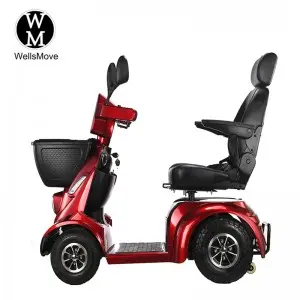Acceleration Performance Test of Elderly Three-wheeled Scooters: Key Indicators and Evaluation Methods
Introduction
In today’s society, with the increasing proportion of the elderly population, the demand for elderly three-wheeled scooters is also growing. This type of scooter provides a convenient way for the elderly to travel and helps them better integrate into social life. For international wholesale buyers, it is crucial to understand the acceleration performance of elderly three-wheeled scooters because it is directly related to the market competitiveness and user experience of the product.
I. The Importance of Acceleration Performance
Acceleration performance is one of the important indicators for measuring the power performance of elderly three-wheeled scooters. Good acceleration performance means that the vehicle can reach a stable speed in a short time, which is essential for the elderly to travel safely and conveniently under different road conditions. For example, when it is necessary to quickly cross an intersection or overtake, good acceleration performance can reduce waiting time and reduce safety hazards.
In addition, acceleration performance is also closely related to the vehicle’s power system, battery performance and overall design. Through the acceleration performance test, it is possible to comprehensively evaluate whether the vehicle’s power output is stable, whether the motor efficiency is efficient, and whether the battery life meets daily use needs.
2. Key indicators of acceleration performance test
(I) 0-20km/h acceleration time
This is an indicator to measure the time required for the elderly three-wheeled scooter to accelerate from a stationary state to 20km/h. Generally speaking, a 0-20km/h acceleration time of less than 10 seconds is considered to be ideal. This indicator can intuitively reflect the power response speed and acceleration ability of the vehicle at the starting stage.
(II) Mid-range acceleration ability
Mid-range acceleration ability refers to the acceleration performance of the vehicle within a certain speed range (such as 10km/h-30km/h). This indicator is of great significance for the elderly to deal with emergencies (such as overtaking or avoiding obstacles) during driving. The shorter the mid-range acceleration time, the stronger the power output of the vehicle, and the faster it can complete the acceleration action.
(III) Acceleration stability
Acceleration stability refers to the stability and balance of the vehicle during acceleration. Since most users of elderly three-wheeled scooters are elderly people, they may feel uncomfortable due to poor body balance when the vehicle accelerates. Therefore, the vehicle should remain stable during acceleration to avoid obvious shaking or tilting.
3. Acceleration performance test method
(I) Test site selection
The acceleration performance test should be carried out on a flat, dry, non-slope hard road surface to ensure the accuracy of the test results. The test site should be spacious enough to meet the safety distance requirements for vehicle acceleration and braking.
(II) Test equipment preparation
Speedometer: used to measure the speed change of the vehicle in real time during the acceleration process to ensure the accuracy of the speed data.
Timer: A high-precision timer is used to record the time required for the vehicle to accelerate from a standstill to a specified speed, with an accuracy of milliseconds.
Inertial measurement unit (IMU): used to monitor the posture changes of the vehicle during acceleration, including pitch angle, roll angle, etc., to evaluate acceleration stability.
(III) Test steps
Vehicle preparation: Adjust the elderly three-wheeled scooter to the best state, ensure that the battery is fully charged, the tire pressure is normal, and the vehicle is fault-free.
Tester in place: Arrange an experienced tester to drive the vehicle to ensure that he is familiar with the vehicle operation and test process.
Start-up acceleration test: The tester drives the vehicle to accelerate from a stationary state, starts the timer and speedometer at the same time, and records the time required for the vehicle to accelerate from 0 to 20km/h.
Mid-stage acceleration test: After the vehicle reaches a speed of 10km/h, it continues to accelerate to 30km/h, and records the time required for this process.
Acceleration stability evaluation: The inertial measurement unit is used to monitor the posture changes of the vehicle during the acceleration process and evaluate the acceleration stability of the vehicle.
4. Acceleration performance evaluation standards
(I) 0-20km/h acceleration time
Excellent: The 0-20km/h acceleration time is within 8 seconds, indicating that the vehicle has excellent power response speed and acceleration ability and can start quickly.
Good: The acceleration time is between 8-10 seconds, and the vehicle’s power performance is relatively ideal and can meet daily travel needs.
Qualified: The acceleration time is between 10-12 seconds, and the vehicle’s power performance basically meets the standard, but it is slightly insufficient in acceleration response speed.
Unqualified: The acceleration time exceeds 12 seconds, the vehicle’s power performance is poor, and the start acceleration is slow, which may affect the travel experience of the elderly.
(II) Mid-range acceleration capability
Excellent: The mid-range acceleration time of 10km/h-30km/h is within 5 seconds. The vehicle has strong power during mid-range acceleration and can complete the acceleration action quickly.
Good: The mid-range acceleration time is between 5-7 seconds. The mid-range acceleration capability of the vehicle is relatively ideal and can meet most usage scenarios.
Qualified: The mid-range acceleration time is between 7-9 seconds. The mid-range acceleration capability of the vehicle basically meets the standard, but the acceleration process may be slightly slow.
Unqualified: The mid-range acceleration time exceeds 9 seconds. The mid-range acceleration capability of the vehicle is poor, which may pose a safety hazard when overtaking or avoiding obstacles.
Post time: Jul-14-2025



